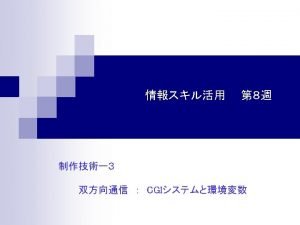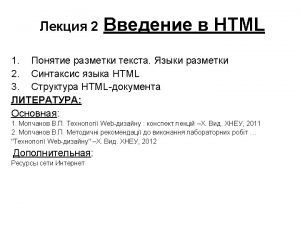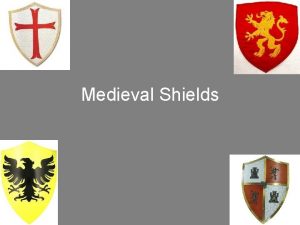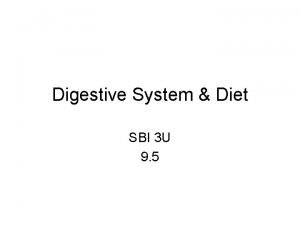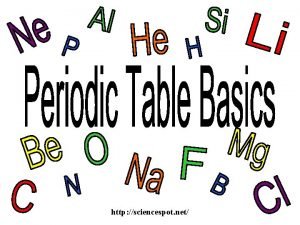http www privatehand comflashelements html Mr Shields Regents

















- Slides: 17

http: //www. privatehand. com/flash/elements. html Mr. Shields Regents Chemistry U 08 L 01 1

John Dalton & Atomic Theory 1803 Check out some Of the names 30 elements were known in 1803 - Dalton came up with the first table of atomic weights. - Atoms of different elements have different weights. 2

Berzelius - 1828 • Published a much better table of atomic masses than Dalton’s – Ex. Based on H = 1 Oxygen was equal to 16. – Introduced the use of LETTERS to symbolize the elements • Replaced use of alchemist symbols • Approximately 51 elements known up to this time 3

Johann Dobereiner (1780 -1849)- triads • 1817: Dobreiner grouped elements based on similarities. • Ca (atomic mass 40), Sr (atomic mass 88), and Ba (atomic mass 137) possess similar chemical properties. • When grouped together as a triad physical properties could be predicted • Examples: Atomic weight, BP, MP, Density This was known as the Theory of Triades 4

Johann Dobereiner - triads Dobereiner’s Triad elements Li Na K Ca Sr Ba Cl Br I Using triads you would predict the atomic weight of strontium Should be midway between the weights of calcium and barium Sr = (40 + 137) ÷ 2 = 88. 5 (actual = 87. 6) 5 a little off, but not too bad!

Triads could not only be used to estimate mass but Also worked reasonably well with other properties Such as mp or density: A+C = B 2 Problem: Density of Ca = 1. 55 g/cm 3 & Ba = 3. 5 g/cm 3 Calculate the density of Strontium? Ans: (1. 55 + 3. 5)/2 = 2. 52; Actual Sr density = 2. 6 g/cm 3 6

Johann Dobereiner - triads Soon other scientists found chemical relationships extended beyond Dobereiner’s triads. Fluorine (F) was added to Cl/Br/I group. Oxygen, sulfur, selenium and tellurium were grouped into a family. Nitrogen, phosphorus, arsenic, antimony, and bismuth were classified as another group. Well, not perfect but it was a start! N P As Sb Bi O S Se Te F Cl Br I 7

John Newlands - Octaves John Newlands – 1837 - 1898 When ordering the elements by atomic weight he noticed the properties of the 8 th element were like the 1 st Li Be B C N O F Na Mg (Noble gases were not then known) And the properties of the 2 nd element were similar to the 9 th and so on. Hence he named this the Law of Octaves (7 Feb 1863). 8

John Newlands - Octaves Newland’s octave arrangement of the elements was ridiculed by the English Chemical Society who refused to Publish his paper. But Newlands was on the right track! Belatedly in 1887 (15 years after his discovery) The Royal Society awarded Newlands the Prestigeous Davy Award. 9

Dmitri Mendeleev (1834 -1907) In the late 1860 s (after Newlands), Mendeleev began working on trying to organize the elements by their properties. In 1869 he achieved his goal by arranging all of the 63 Known elements by their properties and their atomic weights. 10 Dmitri Mendeleev (1834 -1907)

Dmitri Mendeleev Elements were organize into GROUPS having similar Chemical properties. In 1869 Medeleev arranged all of the 63 known elements by their properties and their atomic weights. Where a gap existed in the table, Mendeleev predicted a new element would one day be found! He was right! Three predicted missing elements were found during his Lifetime: Gallium (Ga), scandium (Sc), and germanium (Ge). 11

How did Mendeleev know the element below Al should have a mass of 44? Predicted elements Sc, Ga, Ge Notice the missing Noble gases The noble gases were not discovered until the late 1890’s 12

Mendeleev’s prediction of the element Germanium along with it’s properties NOT BAD! 13

The Periodic Law The PERIODIC LAW forms the basis for the organization of the Periodic Table. “ When elements are arranged in order of Increasing atomic number (mass during Mendeleev’s time) their physical and Chemical properties show a predictable periodic pattern” i. e. the properties of yet undiscovered elements can be predicted based on their apparent location in the Periodic table. 14

Atomic Weights • Between 1860 and 1905, more refined measurements of atomic weights were made. • Additional elements were discovered – Total in 1905 = 84 – Including all the noble gases between 1895 -1905 • Element with the lowest atomic weight is hydrogen. For a while, H was used as the standard for 1 atomic mass. – Today C-12 is the standard (12. 000 amu). 15

Moseley: Atomic Number (1913) • While experimenting with the creation of x-rays he discovered the wavelength of x-rays varied by an integer value (n) from one metal to another according to the equation: (frequency)1/2 = n • interpreted “n” to be the positive charge on the nucleus. • He suggested that the size of the nuclear charge increased by 1 with each step up the Periodic Table – He called “n” the atomic number Henry G. J. Moseley (1887_1915) • Based on Moseley's discovery, the periodic table was reordered by increasing Atomic Number instead of by mass. • This Solved certain problems with Mendeleev's atomic mass sequence in which some elements seemed to be out of order – for example Co/Ni; Te/I 16

The Modern Periodic Table Ordered by Atomic Number How Can you Predict the BP of This new Element? 114 116 118 BP: Xe 166 Rn 211 118 x? 17 (166 + x)/2 = 211 x=256 K
 Doctype html html head
Doctype html html head Doctype html html head
Doctype html html head 1
1 Doctype html html head
Doctype html html head Doctype html html head
Doctype html html head Royal national lifeboat institution founded
Royal national lifeboat institution founded Don shields
Don shields Ck12
Ck12 Medieval times shields
Medieval times shields Busrampwixsite
Busrampwixsite Todd shields contractor
Todd shields contractor Brooke shields face shape
Brooke shields face shape Art shields
Art shields St wilfrid's rc college south shields
St wilfrid's rc college south shields Traps heat shields the surface from harmful radiation
Traps heat shields the surface from harmful radiation Shields parameter
Shields parameter Busramp shields
Busramp shields 5 steps of digestion
5 steps of digestion
